Mulesoft MuleSoft Certified Developer-Level 1 MuleSoft Certified Developer-Level 1 (Mule 4) Online Training
Mulesoft MuleSoft Certified Developer-Level 1 Online Training
The questions for MuleSoft Certified Developer-Level 1 were last updated at Feb 15,2025.
- Exam Code: MuleSoft Certified Developer-Level 1
- Exam Name: MuleSoft Certified Developer-Level 1 (Mule 4)
- Certification Provider: Mulesoft
- Latest update: Feb 15,2025
Refer to the exhibits.
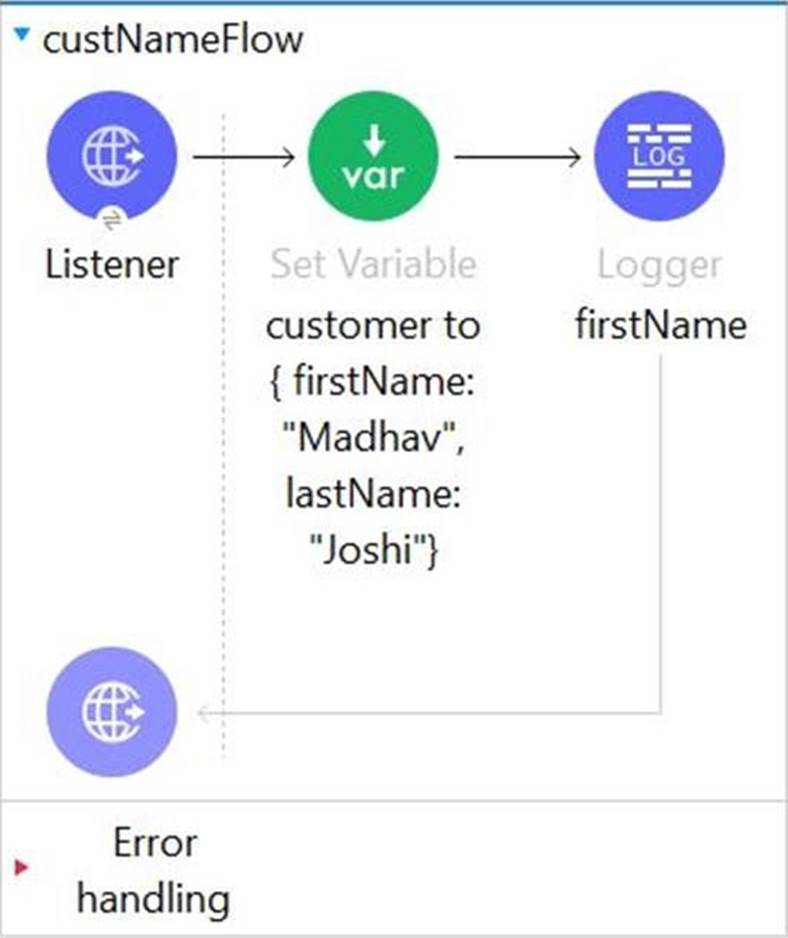

Set paylaod transformer is set the firstName and lastName of the customer as shown in below images.
What is the correct Dataweave expression which can be added in message attribute of a Logger activity to access firstName (which in this case is Madhav) from the incoming event?
- A . firstName
- B . customer.firstName
- C . vars."customer.firstName"
- D . vars."customer"."firstName"
D
Explanation:
Correct answer is vars."customer"."firstName"
Please you can also access firstName using this syntax vars.customer.firstName.
What is not the function of API Gateway?
- A . Determine which traffic is authorized to pass through the API to backend services
- B . Meter the traffic flowing through
- C . Logs all transactions, collecting and tracking analytics data
- D . Specify throttling, security and other policies
D
Explanation:
Correct answer is Specify throttling, security and other policies
MuleSoft Doc
Ref: https://docs.mulesoft.com/api-manager/2.x/api-gateway-capabilities-mule4
API Gateway is responsible for below functions.
1) Determine which traffic is authorized
2) Meter the traffic
3) Logs transaction
4) Apply throttling and other policies (Not specifying. These are specified in API Manager)
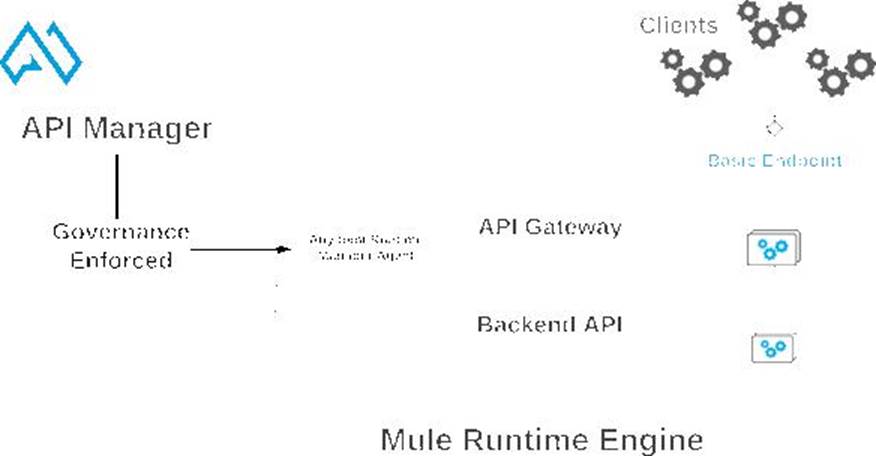
Graphical user interface, text, application
Description automatically generated
What path setting is required for an HTTP Listener endpoint to route all requests to an APIkit router?
- A . /(*)
- B . /
- C . /()
- D . “/*”
D
Explanation:
Option1 is correct syntax to configure HTTP Listener endpoint
Refer to the exhibits.
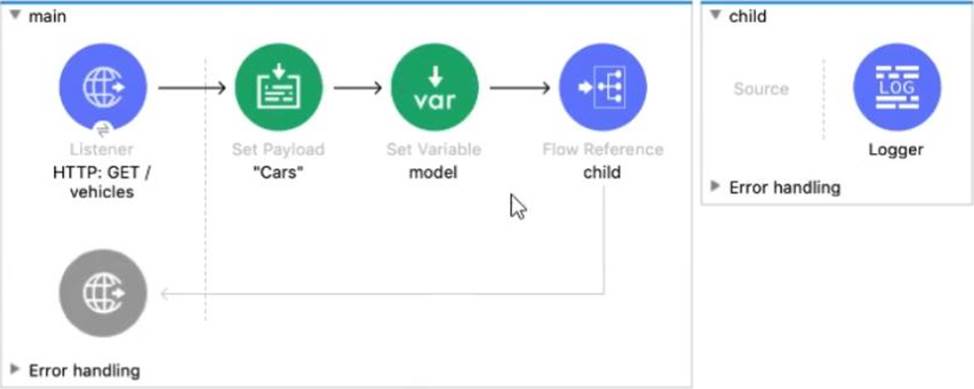
The main flow contains a Flow Reference to the child flow.
A web client sends a GET request to the main flow’s HTTP Listener that includes a make query parameter.
What values are accessible in the child flow?
- A . payload
- B . payload
make query param - C . payload model var
- D . payload
make query param model var
As a part of requirement, application property defined below needs to be accessed as dataweave expression.
What is the correct expression to map it to port value?
- A . { port : p(‘db.port’)}
- B . { port : {db:port}}
- C . { port : p[‘db.port’]}
- D . Application property cannot be accessed in Dataweave
A
Explanation:
Option 1 is the correct syntax
Refer to the exhibits.
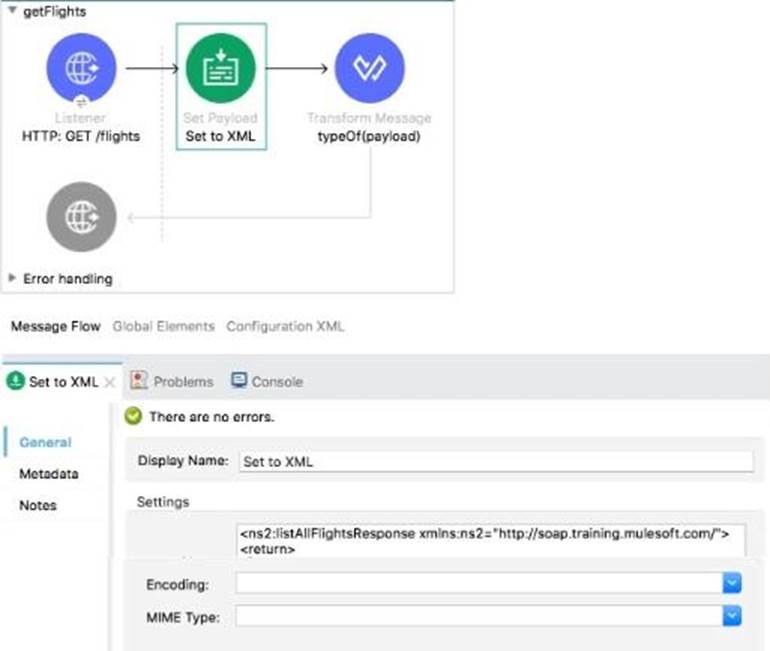
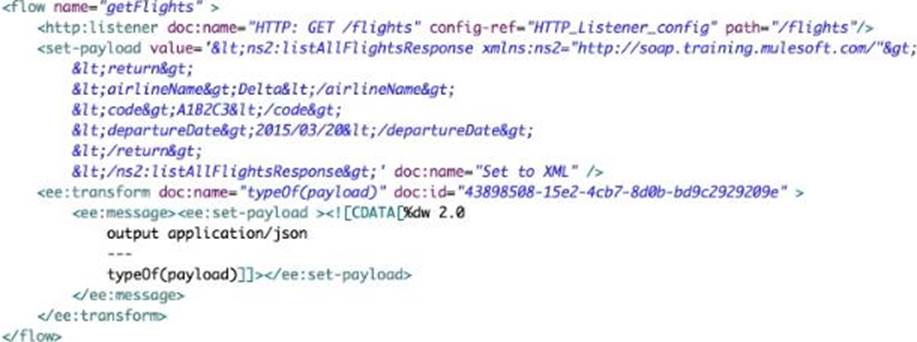
A web client submits a request to http://localhQst:8081 /flights.
What is the result at the end of the flow?
- A . "string"
- B . "Java"
- C . "object"
- D . "XML"
What MuleSoft API-led connectivity layer is intended to expose part of a backend database without business logic?
- A . Data layer
- B . Process layer
- C . Experience layer
- D . System layer
D
Explanation:
Correct answer is System layer
System APIs provide a means for insulating the data consumers from the complexity or changes to the underlying backend systems.
MuleSoft recommends three-layered approach to API-led connectivity, highlighting the three layers:
* System APIs
* Process APIs
* Experience APIs
System APIs are the core systems of record underlying core systems of record (e.g. ERPs, key customer and billing systems, databases, etc.). Process APIs allow you to define a common process which the organization can share, and these APIs perform specific functions, provide access to non-central data, and may be built by either Central IT or Line of Business IT. And finally, the Experience APIs are the means by which data can be reconfigured so that it is most easily consumed by its intended audience, all from a common data source.
The three-layered structure allows for a seamless flow of data from systems of record to new experiences, and allows for reusability of assets rather than point to point connections. This approach provides a distributed and tailored approach to architecture, greater flexibility through loose coupling, and deeper operational visibility into what is being built.
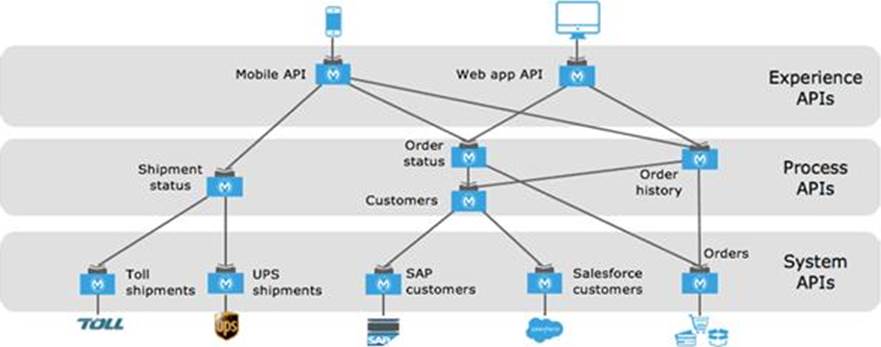
Diagram
MuleSoft MCD-Level-1 : Practice Test Description automatically generated
What MuleSoft API-led connectivity layer is intended to expose part of a backend database without business logic?
- A . Data layer
- B . Process layer
- C . Experience layer
- D . System layer
D
Explanation:
Correct answer is System layer
System APIs provide a means for insulating the data consumers from the complexity or changes to the underlying backend systems.
MuleSoft recommends three-layered approach to API-led connectivity, highlighting the three layers:
* System APIs
* Process APIs
* Experience APIs
System APIs are the core systems of record underlying core systems of record (e.g. ERPs, key customer and billing systems, databases, etc.). Process APIs allow you to define a common process which the organization can share, and these APIs perform specific functions, provide access to non-central data, and may be built by either Central IT or Line of Business IT. And finally, the Experience APIs are the means by which data can be reconfigured so that it is most easily consumed by its intended audience, all from a common data source.
The three-layered structure allows for a seamless flow of data from systems of record to new experiences, and allows for reusability of assets rather than point to point connections. This approach provides a distributed and tailored approach to architecture, greater flexibility through loose coupling, and deeper operational visibility into what is being built.

Diagram
MuleSoft MCD-Level-1 : Practice Test Description automatically generated
What MuleSoft API-led connectivity layer is intended to expose part of a backend database without business logic?
- A . Data layer
- B . Process layer
- C . Experience layer
- D . System layer
D
Explanation:
Correct answer is System layer
System APIs provide a means for insulating the data consumers from the complexity or changes to the underlying backend systems.
MuleSoft recommends three-layered approach to API-led connectivity, highlighting the three layers:
* System APIs
* Process APIs
* Experience APIs
System APIs are the core systems of record underlying core systems of record (e.g. ERPs, key customer and billing systems, databases, etc.). Process APIs allow you to define a common process which the organization can share, and these APIs perform specific functions, provide access to non-central data, and may be built by either Central IT or Line of Business IT. And finally, the Experience APIs are the means by which data can be reconfigured so that it is most easily consumed by its intended audience, all from a common data source.
The three-layered structure allows for a seamless flow of data from systems of record to new experiences, and allows for reusability of assets rather than point to point connections. This approach provides a distributed and tailored approach to architecture, greater flexibility through loose coupling, and deeper operational visibility into what is being built.

Diagram
MuleSoft MCD-Level-1 : Practice Test Description automatically generated
What MuleSoft API-led connectivity layer is intended to expose part of a backend database without business logic?
- A . Data layer
- B . Process layer
- C . Experience layer
- D . System layer
D
Explanation:
Correct answer is System layer
System APIs provide a means for insulating the data consumers from the complexity or changes to the underlying backend systems.
MuleSoft recommends three-layered approach to API-led connectivity, highlighting the three layers:
* System APIs
* Process APIs
* Experience APIs
System APIs are the core systems of record underlying core systems of record (e.g. ERPs, key customer and billing systems, databases, etc.). Process APIs allow you to define a common process which the organization can share, and these APIs perform specific functions, provide access to non-central data, and may be built by either Central IT or Line of Business IT. And finally, the Experience APIs are the means by which data can be reconfigured so that it is most easily consumed by its intended audience, all from a common data source.
The three-layered structure allows for a seamless flow of data from systems of record to new experiences, and allows for reusability of assets rather than point to point connections. This approach provides a distributed and tailored approach to architecture, greater flexibility through loose coupling, and deeper operational visibility into what is being built.

Diagram
MuleSoft MCD-Level-1 : Practice Test Description automatically generated
Latest MuleSoft Certified Developer-Level 1 Dumps Valid Version with 99 Q&As
Latest And Valid Q&A | Instant Download | Once Fail, Full Refund

